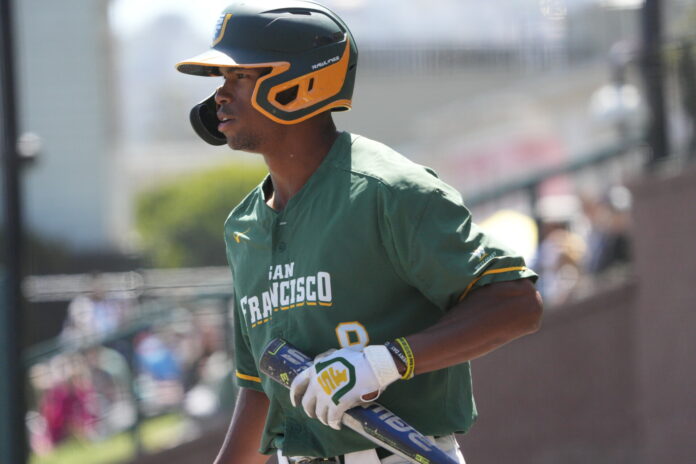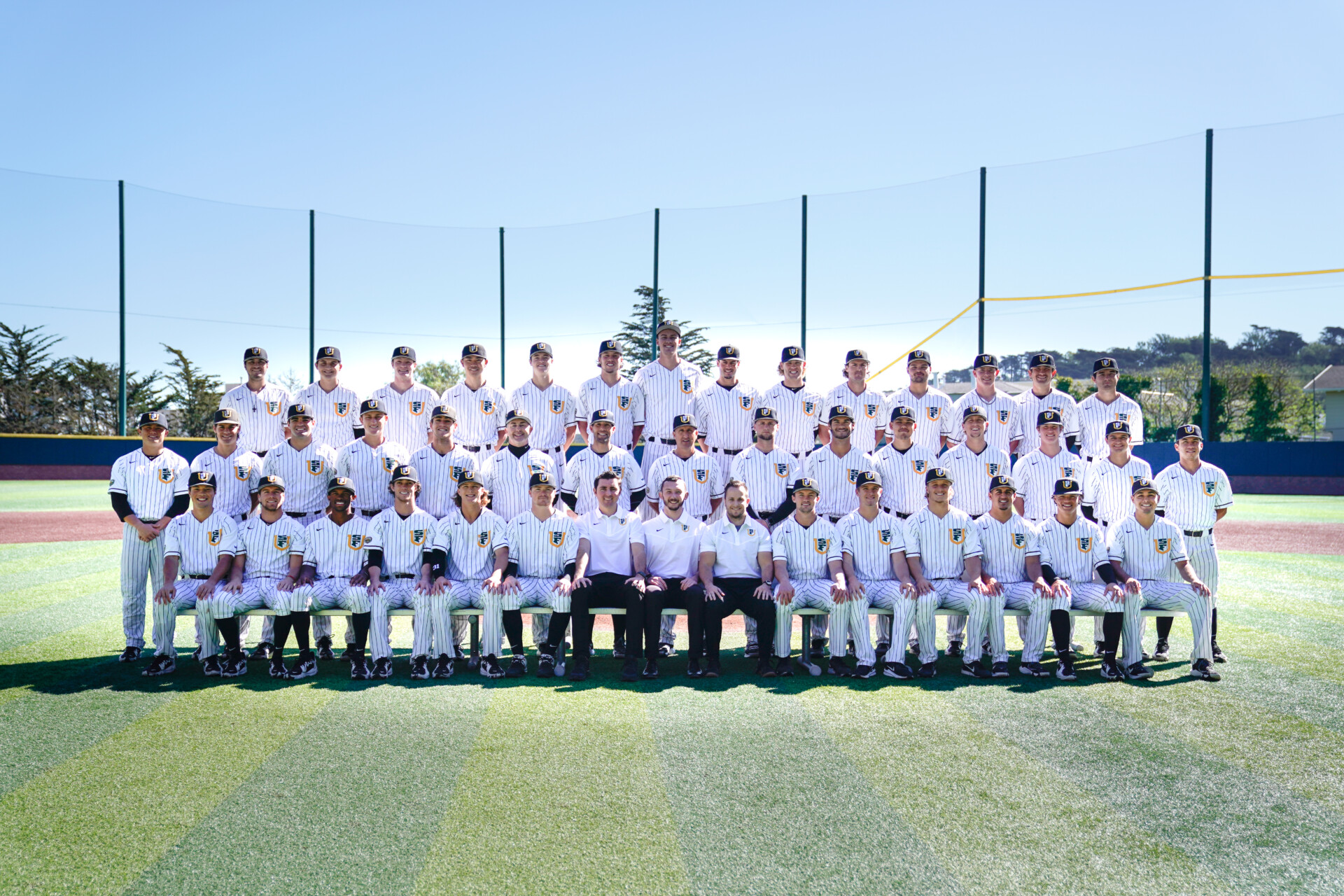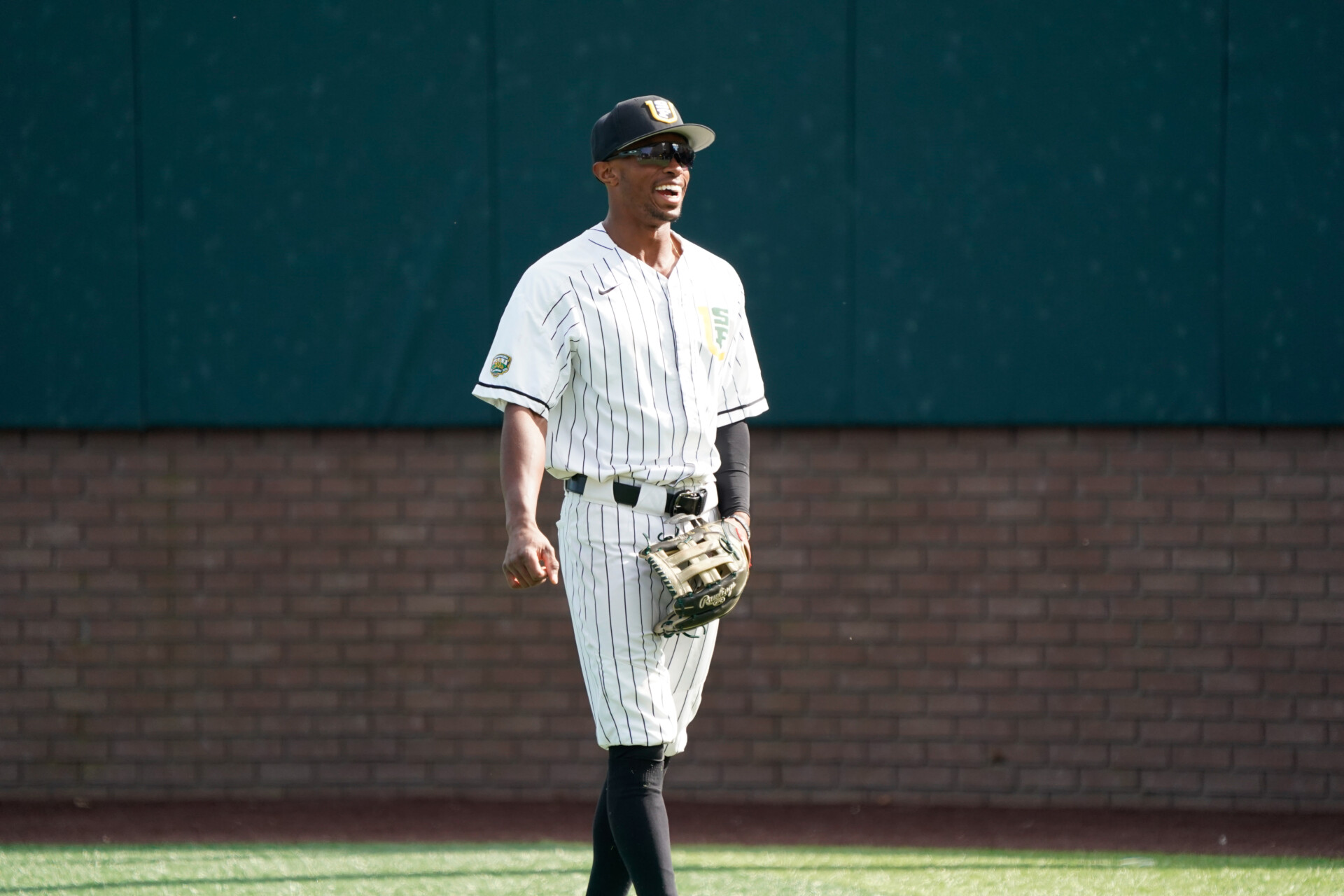
Exploring the racial dynamics of baseball through the eyes of one local college player.
Within seconds of seeing his future teammates, Darius Foster knew he’d be representing his race alone. As he was ushered around the University of San Francisco’s home baseball field during his recruiting visit, Foster saw mainly white faces in his midst. This didn’t necessarily repel him—he knew it would be the same at most other schools.
Before touring the field, Foster had sat down with two current USF players who meant to sell him on their school. They said the same things they’d tell other recruits: how “the Hilltop” (USF’s campus) was a hidden gem inside San Francisco’s heart; how Haight Street, Golden Gate Park, and Ocean Beach were all a Lime scooter’s ride away; how almost every culture’s cuisine was within reach. They spoke, and Foster listened. The players concluded the conversation by explaining what Foster would take with him once his USF baseball days were done: a venerable degree, integration into a prestigious alumni network, teammates who’d blossom into lifelong best friends. And, if he performed well on the field, a chance at his dream: professional baseball.
The conversation ended with smiles all around. Yet what Foster would carry with him throughout his USF tenure had not been addressed: the reality of being Black in the primarily white sport of college baseball.
. . .
The USF baseball team has remained overwhelmingly white for the four years Darius has been on the roster. This is standard in Division 1 college baseball. In 2021, 76 percent of D1 baseball players were white, while 6 percent were Black. When Historically Black Colleges and Universities (HBCUs)—where just one out of every three baseball players is Black—are removed from that data, 4 percent of D1 players were Black, a bit over one per team.
Being one of a few Black players on his team wasn’t new to Darius Foster. Growing up in Georgia, he had been one of two Black kids on his high school baseball team—despite nearly half the school’s 3,500 students being Black.
Foster first got called the N-word while playing on that team. After grounding out to shortstop, a white first baseman hissed at him to “get the hell out of here, n*****.” Foster was sixteen at the time.
This wasn’t an isolated event for Foster on the baseball field. In a flat, emotionless tone, he relayed subsequent incidents where the slur was hurled at him, lowering his voice to ensure he wasn’t overheard. Even at a whisper, the hard “-er” sounded acidic as it crawled from his mouth.
Foster told me this while we sat at a maroon booth one floor under the USF cafeteria. He had agreed to speak with me as soon as I expressed my desire to write about his experience. Although I had always wondered how Foster handled his racial isolation during the two years we played at USF together (Foster had one Black teammate in 2021, after I graduated), I had never asked him about it. I also figured that, being a white man and former D1 athlete, I should attempt to understand my role in college baseball’s racial landscape.
Foster began his college baseball career in 2017 at then-perennial powerhouse Oregon State. He was one of two Black players on that team, too, but said that he wasn’t treated differently because of his race. Oregon State’s coaches only valued players’ on-field production.
Foster felt stuck. Behind several older, more accomplished outfielders on the depth chart, he redshirted his freshman season, saw no playing time, and decided to leave Oregon State once the season ended.
In fall of 2018, he transferred to Contra Costa College, a junior college in San Pablo, California. Foster chose CCC largely because of its proximity to Oakland, where he was born and where much of his extended family still lives.
CCC also had another appeal. “We called it Chocolate City College because it was all Black guys on the team,” he said, chuckling.
Foster hadn’t had multiple teammates with his same skin color before. It made for a fresh atmosphere, both on and off the field.
“There was more mutual respect and an implied sense of trust between everyone [at CCC],” he said. “Especially with the coaches. We didn’t have to worry whether they had our backs.”
While discussing CCC, Foster seemed at ease for the first time during our conversation—as if recounting those days restored the relaxation he enjoyed there. Baseball is, after all, a game of muscle memory.
“Before CCC, I didn’t realize that I had to be more consistent and work twice as hard as white teammates to show my worth,” he said. “My white coaches and teammates weren’t making me feel that on purpose, but I think it’s just part of the sport.”
With that, the elephant in our booth was addressed. Before this statement, I had worried whether Foster would feel comfortable enough to be honest talking about his white teammates with a, well, white teammate. And perhaps his initial discomfort was because he didn’t know how I’d take the potential criticism.
This moment was crucial. We couldn’t speak honestly and openly to one another without first acknowledging that Foster and every other Black baseball player’s plight is linked to every white person whose skin is the game—mine included. This culture of whiteness is undoubtedly “part of the sport.”
Whether it was his grandpa’s home-cooked red beans and rice, the lower-level junior college competition, his trusting teammates, or a combination of the three, Darius Foster had an excellent spring 2019 season at CCC, scoring 34 runs, tallying 13 extra-base hits, and stealing an absurd 38 bases in 39 games. He received Division 1 interest again once the season ended. One school stuck out to him: the University of San Francisco.
Foster committed to USF two weeks after that initial recruiting visit. It ended up being an easy choice: not only would he remain near family, but because of the familial culture he perceived during his visit, USF had the potential to become a brotherhood for him—despite the lack of Black guys.

Foster arrived at USF in fall 2019. Integrating into the team proved more challenging than he expected. He was shy, and many of his white teammates’ inclusion efforts manifested in microaggressions: greeting him with a different handshake than they used with everyone else, or switching diction away from their default to something that resembled the rap lyrics echoing through the locker room.
There was also more overt racism: jokes leaning on tired stereotypes, or racially motivated comments about Foster’s outfits and accessories. I heard or saw some form of these incidents more days than not. Yet, like my fellow white teammates, I didn’t condemn them.
If I had to defend my own silence back then, I would have said that everyone in USF baseball got teased, most often about aesthetic insecurities: a thinning hairline, perhaps, or a droopy right eyelid in my case. But I see now that wisecracks about a white guy’s physical flaws are one thing; racist quips toward a team’s sole Black player are on a different level. Especially on a sports team, where building unity through shared passion and collective purpose is the driving force.
. . .
Trust and success are tethered in baseball. A player must trust his teammates and coaches to guide him on the field, literally and figuratively.
For instance: imagine Darius Foster just hit a double and is now safe at second base. The next hitter smacks a line drive into right field that prompts Foster to head for third base. As he reaches third, he looks at his third-base coach, who’ll be either holding his right arm extended with palm out like he’s using The Force to slow Foster down, or waving his left arm like a windmill. The former signals Foster to stop at third while the latter sends him home to score.
Foster requires this guidance because he can’t run while also watching the ball. Therefore, his coach watches the ball for him and judges whether he’ll be safe at home. Foster must trust that judgment.
Another example: Foster is playing left field. His pitcher serves a lazy fastball to the hitter and the ball is sent on a soaring arc toward the left-field fence. Instinct propels Foster to sprint toward the fence at full speed. But if he’s to catch that white ball, he can’t take his eyes off it lest it get lost in the clouds.
What does he do?
He listens to his center fielder. Once Foster reaches the warning track, it’s the center fielder’s duty to warn him by yelling “Wall!” This wall call won’t stop Foster, but crashing into a wall one anticipates is less dangerous than an unexpected collision.
If the center fielder’s call comes too late, Foster will likely slam into said wall and suffer a serious injury. Therefore, Foster’s physical well-being depends on trusting his teammate.
This trust can’t be built in a second. It takes time to cultivate, and its seed is planted in the locker room—blighted, in Foster’s case, by racist comments.
When I asked Foster about the wisecracks, he said, “None of that stuff really bothered me. I’ve heard jokes like that all my life, so it wasn’t anything new. Besides, we’re all a team. We’re all brothers. We win together and lose together.”
Foster has heard these jokes and the subtle (and overt) racism they reveal all his life—they’ve been normalized as a part of his experience playing a predominately white sport.
. . .
When pondering why he has so few Black peers in Division 1 baseball, Foster said, “I think younger guys are taught to believe that the sport has it out for Black players. That’s why they’re drawn to HBCUs and junior colleges like CCC. It’s where they feel comfortable and trust those around them.”

At CCC, Foster found the trust and camaraderie he’d been seeking all his baseball life—and he flourished on the field. But then he left it for USF—a white-dominant Division 1 team—after one season.
Why? Because he knew USF presented the straightest path toward professional baseball.
Of the 612 players selected in the 2021 MLB Draft, 497 came straight from college. Of those, 430 were drafted from a Division 1 team, and only 47 came from a junior college. If Foster wanted the best chance to achieve his dreams, he had to play for white coaches (only three non-HBCU schools with Division 1 baseball programs had Black head coaches in 2021) alongside mostly white teammates—if not at USF, then it would have been at any other D1 school.
. . .
Foster doesn’t feel that all white men in college baseball are complicit. During our conversation, he told me a story of a former coach who invited Foster to his home for Christmas Eve dinner in 2019. Foster shared a wonderful evening full of honest and engaging discussions with his coach’s family and used this story to illustrate how he’s found comfort at USF. The gesture showed Foster that he was valued as a person first and a player second—which he hadn’t felt from a white coach before. This display fed a mutual trust that Foster still holds dear.
It would be easy for me to use this anecdote as proof that college baseball’s race problem isn’t black-and-white, so to speak. Yet just because there are white people who have made Foster feel welcome doesn’t mean the overarching issues have been solved. The overwhelming whiteness persists, with Black men significantly outnumbered at every level of the sport. Rather than white players and coaches cultivating an environment of trust and comfort for Black players, Black players are instead expected to assimilate into the traditional team structures and environments white people in baseball have inhabited for decades.
. . .
Jermaine Clark has experienced baseball’s pervasive whiteness firsthand, from multiple vantage points. Clark is a Black man and a former MLB player who played between 2001 and 2005, was an assistant coach at Fresno State for two seasons, and currently works as a scout for the Colorado Rockies. Like Foster and me, Clark played college baseball at the University of San Francisco. He was a two-time All-American there and, in 2005, was inducted into the USF Sports Hall of Fame.
Clark, who played for USF between 1995 and 1997, was the team’s lone Black player during the 1997 season—and per his memory, he was the only Black baseball player in the West Coast Conference that year.
When I asked him why college baseball remains as white as when he left it, Clark described the stubborn inertia of the status quo.
“It takes a conscious effort to get comfortable being uncomfortable, and most coaches aren’t willing to make that effort,” he said. “Only a bright-minded and confident coach could walk into a Black potentially single-parent household, and have honest, vulnerable conversations about what it will take, financially, for a kid to play college baseball, let alone at a private school like USF.
“They’d rather scout the same white players from the same regions each year than look for diamonds in the rough in inner-city areas. Roster diversity isn’t enough incentive to vacate their comfort zone.”
Clark, born in Berkeley, was one such hidden jewel. While being recruited, only one coach visited Clark’s home: USF’s then–head coach, Rich Hill. Hill shared a meal with Clark and his family, facilitated an honest discussion, and offered Clark enough scholarship money to make USF affordable for his parents.
Clark accepted the scholarship and became one of the most decorated baseball players in school history.
During our discussion, Clark made it clear that baseball’s racial dynamics are a deep-seated issue that’s rooted in financial inequality, starting at the youth level and extending up to the major leagues. He’s optimistic that change can occur, and it can start with small steps—namely constant, conscious, uncomfortable conversations.
Conversations that build on what’s already working on the baseball field.
When teams don their jerseys and hit the turf, they work as a cohesive unit. Darius Foster trusts his teammates to tell him when he’s about to collide with the outfield wall and he trusts his coaches to tell him whether he’ll be safe at home when rounding third base. Each scenario involves honest communication, and when done correctly, Foster’s safety aligns with his team’s success. When everybody stays on the same page, trust is fostered. Baseball can build on this foundation of honest talk.
. . .
Foster believes that he can build on that too.
“It’s all about being the proof,” he said. “Succeeding [at USF] and showing younger guys that there is a place for us in college baseball,” he said.
He meant succeeding on the field, which he’s certainly done. During the 2022 season, Foster set the USF school record for the most stolen bases in a game: five. He’s clocked an extraordinary forty stolen bases in his USF career—with one full season left. Although it’s a long shot, he has a chance to break USF’s career stolen base record of eighty-six. The record holder? Jermaine Clark.
But I believe Foster’s biggest impact may come off the field. After all, he graduated from the University of San Francisco in 2022 with a bachelor’s in psychology and a minor in business. He’s now enrolled in USF’s Master of Science in Entrepreneurship and Innovation graduate program while working as an ad analyst at a digital marketing company—all while still playing at USF, where he’s now a team captain. That is success.
. . .
Foster’s LinkedIn profile photo pictures him with his baseball glove on hand, wearing USF’s black-and-gold uniform. It coordinates with his profile’s background image: a black background with a golden BLACK LIVES MATTER in the middle, with gray concentric circles emanating outward with increasing thickness. The circles resemble a pond’s ripple when something disturbs its stagnancy. ♦
Grant Young has an MFA from the University of San Francisco. His work has been published by HAD, The Twin Bill, JAKE, and others. He’s currently revising an essay collection that focuses on his reckoning with Division 1 baseball’s dark underbelly.


